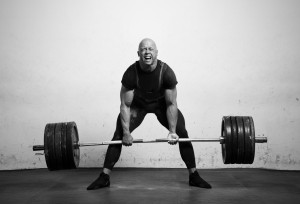
Squatting exercises are compound, time-tested exercises that target hamstring, quadriceps and the glutes muscles. The ACE ( American Council on Exercise) regards squats as an entire body exercise, which comes highly recommended to incorporate in most fitness routines.
Machines are not needed in order to achieve interesting types of variations for this exercise. Squats with weights exercises can up any fitness challenge routine.
Dumbells Used For Squat Exercises
Using dumbbells for a type of intermediate front squat can be done anywhere. The individual will need to hold onto a pair of appropriate dumbbells, while standing with the feet just a little wider than shoulder length apart. The core muscles will need to be in a brace position by tightening up the abdominal muscles and the dumbbells will need to be bought up to the position of resting on each shoulder.
The knees must be bent, hips faced back and down so that the thighs are in a parallel position to the floor. From this position the knees must be straightened out doing two sets of 12 repetitions.
Using The Wall And A Ball
To do this exercise, hold a pair of dumbbells in each hand and then place an exercise ball against a wall pushing it on the small of the back. Feet will need to be about shoulder width apart and walk a few steps forward away from the wall. The knees need to be bent, squatting down until the thighs are in a parallel position to the floor.
The ball should roll up the back and then progress onto straightening the legs to a standing position. With these squats, exercises can be done using two sets of ten repetitions.
Hack Squats
This is a type of advanced squat using a barbell. The barbell should be placed on the floor behind the body. The exercise involves squatting down and reaching for the barbell with both hands using an overhand type of grip. The back should remain straight with the chin level and return to a standing position with the barbell bar in the hands.
At this stage the individual should return to a squatting position. The back and the arms should remain straight throughout the exercise and the toes and the knees should be facing in the same direction. Two sets of twelve repetitions are advisable for the exercise routine.
Squat Mythology
The ACE states that there are no specific rules and regulations in place in relation to squats with weights exercises. Many of the squat techniques used depend on the individual’s body and the type of exercise goals in mind. One of the myths about squatting exercises is to never allow the knees to go further than beyond the toes. However, it has been proven that allowing the knees to extend past the toes is regarded as a healthy and perfectly normal type of “range of motion”.
Individuals who exercise regularly will know how to listen to what their bodies are telling them in regards to a good or bad type of exercise. There are various squatting exercises available according to the level of experience.
 There are many benefits to dead-lifting that makes it advantageous as workouts for bodybuilders as well as weightlifters. Because dead-lifting requires the use of all major muscle groups, it provides overall strength and growth to muscle groups such as quads, hamstrings, glutes, spinal erectors, obliques, abdominals and lower back muscles. A single deadlift is equivalent to a combination of several strength exercises such as leg presses, abdominal crunches and squats.
There are many benefits to dead-lifting that makes it advantageous as workouts for bodybuilders as well as weightlifters. Because dead-lifting requires the use of all major muscle groups, it provides overall strength and growth to muscle groups such as quads, hamstrings, glutes, spinal erectors, obliques, abdominals and lower back muscles. A single deadlift is equivalent to a combination of several strength exercises such as leg presses, abdominal crunches and squats. Dumbbell squats are an excellent alternative to barbell squats. They are perfect for all bodybuilding beginners who want to build mass the safe way. Squats are essential for building the quads and glutes, but they also stimulate growth in other muscle groups, therefore they should be part of any bodybuilding routine.
Dumbbell squats are an excellent alternative to barbell squats. They are perfect for all bodybuilding beginners who want to build mass the safe way. Squats are essential for building the quads and glutes, but they also stimulate growth in other muscle groups, therefore they should be part of any bodybuilding routine.
 The snatch grip deadlift is a popular compound lift that is used in
The snatch grip deadlift is a popular compound lift that is used in